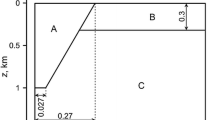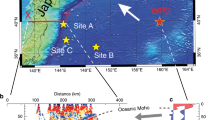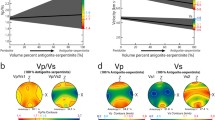Abstract
A diapiric mechanism is presented to explain geochemical data on the thermal structure of the upper mantle. It is emphasised that any model to fit the data cannot be a steady state model, and it is concluded that the data are inconsistent with the popular interpretation of the seismic low velocity zone as a partially melted region.
Similar content being viewed by others
References
Boyd, F. R., Geochim. cosmochim. Acta, 37, 2533 (1973).
Macgregor, I. D., Am. Miner. (in the press).
Macgregor, I. D., Physics and Chemistry of the Earth, Kimberlite conference volume (in the press).
Davis, B. T. C., and Boyd, F. R., J. geophys. Res., 71, 3567 (1966).
Nixon, P. H., and Boyd, I. D., in Lesotho Kimberlites (edit. by Nixon, P. H.), 48 (Lesotho National Development Corporation, Maseru, 1973).
Boullier, A. M., and Nicolas, A., in Lesotho Kimberlites (edit. by Nixon, P. H.), 57 (Lesotho National Development Corporation, Maseru, 1973).
Boullier, A. M., and Nicolas, A., Physics and Chemistry of the Earth, Kimberlite conference volume (in the press).
Nixon, P. H., Boyd, F. R., and Boullier, A. M., in Lesotho Kimberlites (edit. by Nixon, P. H.), 312 (Lesotho National Development Corporation, Maseru, 1973).
Kushiro, I., in Lesotho Kimberlites (edit. by Nixon, P. H.), 294 (Lesotho National Development Corporation, Maseru, 1973).
Boyd, I. D., and Nixon, P. H., in Lesotho Kimberlites (edit. by Nixon, P. H.), 254 (Lesotho National Development Corporation, 1973).
Clark, S. P., and Ringwood, A. E., Rev. Geophys., 2, 35 (1964).
Landau, L., and Lifchitz, E. M., Mécanique des fluides (edit. by Mir, M.), (1971).
Carslaw, H. S., and Jaeger, J. C., Conduction of heat in solids, (Oxford, 1959).
Loomis, T. P., Bull. geol. Soc. Am., 83, 2475 (1972).
Ito, K., and Kennedy, G. C., Am. J. Sci., 265, 519 (1967).
Boettcher, A. L., Mysen, B. O., and Modreski, P. J., International conference on Kimberlites, extended abstracts, 35 (1973).
Klemens, P. G., Solid State Physics (edit. by Seitz, F., and Turnbull, D.), 7, 1 (1958).
Anderson, O. L., and Perkins, P. C., J. geophys. Res., 79, 2136 (1974).
Green, H. W. II, Nature phys. Sci., 238, 2 (1972).
Gueguen, Y., and Mercier, J. M., Phys. Earth planet. Interiors., 7, 39 (1973).
Green, H. W. II, and Radcliffe, S. V., Earth planet. Sci. Lett., 15, 239 (1972).
Green, H. W. II, and Radcliffe, S. V., in Flow and Fracture of Rocks, Geophysical Monograph, 16, 139 (Am. geophys. Union, Washington, 1972).
Post, R. L., jun., and Griggs, D. T., Science, 181, 1242 (1973).
Author information
Authors and Affiliations
Rights and permissions
About this article
Cite this article
Green, H., Gueguen, Y. Origin of kimberlite pipes by diapiric upwelling in the upper mantle. Nature 249, 617–620 (1974). https://doi.org/10.1038/249617a0
Received:
Revised:
Issue Date:
DOI: https://doi.org/10.1038/249617a0
- Springer Nature Limited
This article is cited by
-
An integrated model of kimberlite ascent and eruption
Nature (2007)
-
Petrogenesis of ultramafic and mafic xenoliths from Mesozoic basanites in southern Sweden: constraints from mineral chemistry
International Journal of Earth Sciences (2007)
-
Melt topology in partially molten mantle peridotite during ductile deformation
Nature (1994)
-
Infrared spectroscopic investigation of hydroxyl in β-(Mg,Fe)2SiO4 and coexisting olivine: Implications for mantle evolution and dynamics
Physics and Chemistry of Minerals (1993)
-
Trace-element zonation in garnets from The Thumb: heating and melt infiltration below the Colorado Plateau
Contributions to Mineralogy and Petrology (1991)





